Assessment of and Adaptation to Beach Erosion in Islands: An Integrated Approach
Abstract
:1. Introduction
2. Materials and Methods
2.1. Prioritization Framework Using a Multi-Criteria Approach (Step 1)
2.2. Coastal Geomorphology and Hydrodynamics (Step 2)
2.3. Estimation of Beach Nourishment Requirements (Step 3)
2.4. Marine Aggregate Survey (Step 4)
3. Results: Framework Implementation
3.1. Island Beach Prioritization for Adaptation Response
3.2. Geomorphology and Hydrodynamics
3.2.1. Geomorphology
3.2.2. Hydrodynamic Observations
3.2.3. Simulations
3.3. Beach Nourishment Requirements
3.4. Marine Aggregate (MA) Potential for Beach Nourishment
4. Discussion and Conclusions
Author Contributions
Funding
Institutional Review Board Statement
Informed Consent Statement
Data Availability Statement
Conflicts of Interest
References
- Luijendijk, A.; Hagenaars, G.; Ranasinghe, R.; Baart, F.; Donchyts, G.; Aarninkhof, S. The State of the World’s Beaches. Sci. Rep. 2018, 8, 6641. [Google Scholar] [CrossRef]
- Ackerman, R.A. The nest environment and the embryonic development of sea turtles. In The Biology of Sea Turtles; Lutz, P.L., Musick, J.A., Eds.; CRC Press: Boca Raton, FL, USA, 2017; Volume I, pp. 83–106. [Google Scholar]
- Neumann, B.; Vafeidis, A.T.; Zimmermann, J.; Nicholls, R.J. Future Coastal Population Growth and Exposure to Sea-Level Rise and Coastal Flooding—A Global Assessment. PLoS ONE 2015, 10, e0118571. [Google Scholar] [CrossRef] [PubMed] [Green Version]
- UNWTO. International Tourism Highlights, 2019th ed.; United Nations World Tourism Organisation: Madrid, Spain, 2019; Available online: https://www.e-unwto.org/doi/epdf/10.18111/9789284421152 (accessed on 1 June 2021).
- Tzoraki, O.; Monioudi, I.; Velegrakis, A.; Moutafis, N.; Pavlogeorgatos, G.; Kitsiou, D. Resilience of touristic island beaches under sea level rise: A methodological framework. Coast. Manag. 2018, 46, 78–102. [Google Scholar] [CrossRef]
- Toimil, A.; Díaz-Simal, P.; Losada, I.J.; Camus, P. Estimating the risk of loss of beach recreation value under climate change. Tour. Manag. 2018, 68, 387–400. [Google Scholar] [CrossRef]
- Hinkel, J.; Nicholls, R.J.; Tol, R.S.J.; Wang, Z.B.; Hamilton, J.M.; Boot, G.; Vafeidis, A.T.; McFadden, L.; Ganopolski, A.; Klein, R.J.T. A global analysis of erosion of sandy beaches and sea-level rise: An application of DIVA. Glob. Planet. Chang. 2013, 111, 150–158. [Google Scholar] [CrossRef]
- IPCC. Climate Change 2014: Impacts, Adaptation, and Vulnerability. Part A: Global and Sectoral Aspects. Contribution of Working Group II to the Fifth Assessment Report of the Intergovernmental Panel on Climate Change; Cambridge University Press: Cambridge, UK; New York, NY, USA, 2014. [Google Scholar]
- Mentaschi, L.; Vousdoukas, M.; Pekel, J.-F.; Voukouvalas, E.; Feyen, L. Global long-term observations of coastal erosion and accretion. Sci. Rep. 2018, 8, 12876. [Google Scholar] [CrossRef] [Green Version]
- Flor-Blanco, G.; Alcántara-Carrió, J.; Jackson, D.W.T.; Flor, G.; Flores-Soriano, C. Coastal erosion in NW Spain: Recent patterns under extreme storm wave events. Geomorphology 2021, 387, 107767. [Google Scholar] [CrossRef]
- Guisado-Pintado, E.; Jackson, D.W.T. Coastal impact from high-energy events and the importance of concurrent forcing parameters: The cases of Storm Ophelia (2017) and Storm Hector (2018) in NW Ireland. Front. Earth Sci. 2019, 7, 190. [Google Scholar] [CrossRef] [Green Version]
- Nicholls, R.J.; Cazenave, A. Sea-Level Rise and Its Impact on Coastal Zones. Science 2010, 328, 1517–1520. [Google Scholar] [CrossRef] [PubMed]
- Ranasinghe, R. Assessing climate change impacts on open sandy coasts: A review. Earth-Sci. Rev. 2016, 160, 320–332. [Google Scholar] [CrossRef] [Green Version]
- Monioudi, I.N.; Karditsa, A.; Chatzipavlis, A.; Alexandrakis, G.; Andreadis, O.; Velegrakis, A.F.; Poulos, S.; Ghionis, G.; Petrakis, S.; Sifnioti, D.; et al. Assessment of vulnerability of the eastern Cretan beaches (Greece) to sea level rise. Reg. Environ. Chang. 2016, 16, 1951–1962. [Google Scholar] [CrossRef]
- Peduzzi, P.; Velegrakis, A.F.; Estrella, M.; Chatenoux, B. Integrating the role of ecosystems in disaster risk and vulnerability assessments: Lessons from the Risk and Vulnerability Assessment Methodology Development Project (RiVAMP) in Negril Jamaica. In The Role of Ecosystems in Disaster Risk Reduction; Renaud, F.G., Ed.; United Nations University Press: Tokyo, Japan, 2013; pp. 109–139, ISBN-13: 978-9280812213. [Google Scholar]
- Romine, B.M.; Fletcher, C.H.; Neil Frazer, L.; Anderson, T.R. Beach erosion under rising sea-level modulated by coastal geomorphology and sediment availability on carbonate reef-fringed island coasts. Sedimentology 2016, 63, 1321–1332. [Google Scholar] [CrossRef]
- SETE. Association of the Greek Touristic Businesses, International Airline Arrivals: 2015 & Planning Report (Slots). 2016. Available online: http://sete.gr/media/4629/ypa-2015-and-slots-2016.pdf (accessed on 20 May 2021).
- UNWTO. Tourism Highlights. United Nations World Tourism Organisation; UNWTO: Madrid, Spain, 2017; ISBN 9789284419029. [Google Scholar]
- Vousdoukas, M.I.; Mentaschi, L.; Voukouvalas, E.; Verlaan, M.; Jevrejeva, S.; Jackson, L.; Feyen, L. Global probabilistic projections of extreme sea levels. Nat. Commun. 2018, 9, 2360. [Google Scholar] [CrossRef] [Green Version]
- Bellard, C.; Leclerc, C.; Courchamp, F. Impact of sea level rise on the 10 insular biodiversity hotspots. Glob. Ecol. Biogeogr. 2014, 23, 203–212. [Google Scholar] [CrossRef]
- Monioudi, I.; Velegrakis, A.; Chatzipavlis, A.; Rigos, A.; Karambas, T.V.; Vousdoukas, M.; Hasiotis, T.; Koukourouvli, N.; Peduzzi, P.; Manoutsoglou, E.; et al. Assessment of island beach erosion due to sea level rise: The case of the Aegean archipelago (Eastern Mediterranean). Nat. Hazards Earth Syst. Sci. 2017, 17, 449–466. [Google Scholar] [CrossRef] [Green Version]
- Asariotis, R. Climate change and adaptation for coastal transport infrastructure: A sustainable development challenge for SIDS in the Caribbean and beyond. In The Handbook of Natural Resources, 2nd ed.; Coastal and Marine Environments; Wang, Y., Ed.; CRC Press: Boca Raton, FL, USA, 2020; pp. 253–264. [Google Scholar]
- Leal Filho, W.; Krishnapillai, M.; Sidsaph, H.; Nagy, G.J.; Luetz, J.M.; Dyer, J.; Otoara Ha’apio, M.; Havea, P.H.; Raj, K.; Singh, P.; et al. Climate Change Adaptation on Small Island States: An Assessment of Limits and Constraints. J. Mar. Sci. Eng. 2021, 9, 602. [Google Scholar] [CrossRef]
- Vousdoukas, M.I.; Mentaschi, L.; Hinkel, J.; Ward, P.J.; Mognelli, I.; Ciscar, J.C.; Feyen, L. Economic motivation for raising coastal flood defenses in Europe. Nat. Commun. 2020, 11, 2119. [Google Scholar] [CrossRef] [PubMed]
- Narayan, S.; Beck, M.W.; Reguero, B.G.; Losada, I.J.; van Wesenbeeck, B.; Pontee, N.; Sanchirico, J.N.; Ingram, J.C.; Lange, J.-M.; Burks-Copes, K.A. The Effectiveness, Costs and Coastal Protection Benefits of Natural and Nature-Based Defences. PLoS ONE 2016, 11, e0154735. [Google Scholar] [CrossRef] [Green Version]
- Toimil, A.; Losada, I.J.; Camus, P.; Díaz-Simal, P. Managing coastal erosion under climate change at the regional scale. Coast. Eng. 2017, 128, 106–122. [Google Scholar] [CrossRef]
- Semeoshenkova, V.; Newton, A. Overview of erosion and beach quality issues in three Southern European countries: Portugal, Spain and Italy. Ocean. Coast. Manag. 2015, 118, 12–21. [Google Scholar] [CrossRef]
- Summers, A.; Fletcher, C.H.; Spirandelli, D.; McDonald, K.; Over, J.-C.; Anderson, T.; Barbee, M.; Romine, B.M. Failure to protect beaches under slowly rising sea level. Clim. Chang. 2018, 151, 427–443. [Google Scholar] [CrossRef] [Green Version]
- Velegrakis, A.F.; Ballay, A.; Poulos, S.; Radzevičius, R.; Bellec, V.; Manso, F. European marine aggregates resources: Origins, usage, and mining techniques. J. Coast. Res. 2010, 51, 1–14. [Google Scholar]
- Hasiotis, T.; Gazis, I.-Z.; Anastasatou, M.; Manoutsoglou, E.; Velegrakis, A.F.; Kapsimalis, V.; Karditsa, A.; Stamatakis, M. Searching for potential marine sand resources to mitigate beach erosion in island settings. Mar. Georesour. Geotechnol. 2020, 39, 527–542. [Google Scholar] [CrossRef]
- Kapsimalis, V.; Kyriakidou, C.; Chatzinaki, M.; Voulouvalas, E.; Panagiotopoulos, I.; Pappas, G.; Petrakis, S.; Tsoutsia, A.; Anagnostou, C.H. Natural and human-induced changes in two touristic beaches of SE Chios Island. In Proceedings of the 11th Hellenic Symposium of Oceanography and Fisheries, Mytilene, Lesvos, Greece, 13–17 May 2015; pp. 741–744. [Google Scholar]
- Zavadskas, E.K.; Mardani, A.; Turskis, Z.; Jusoh, A.; Nor, K.M.D. Development of TOPSIS Method to Solve Complicated Decision-Making Problems—An Overview on Developments from 2000 to 2015. Int. J. Inf. Technol. Decis. Making. 2016, 15, 645–682. [Google Scholar] [CrossRef]
- McKenna, J.; Williams, A.T.; Cooper, J.A.G. Blue flag or red herring: Do beach awards encourage the public to visit beaches? Tour. Manag. 2011, 32, 576–588. [Google Scholar] [CrossRef]
- Saaty, T.L. Risk—Its priority and probability: The analytic hierarchy process. Risk Anal. 1987, 7, 159–172. [Google Scholar] [CrossRef]
- Saaty, T.L. Relative measurement and its generalization in decision making why pairwise comparisons are central in mathematics for the measurement of intangible factors the analytic hierarchy/network process. Revista de la Real Academia de Ciencias Exactas, Fisicas y Naturales—Serie A. Matematicas 2008, 102, 251–318. [Google Scholar]
- Vousdoukas, M.I.; Mentaschi, L.; Voukouvalas, E.; Verlaan, M.; Feyen, L. Extreme Sea levels on the rise along Europe’s coasts. Earths Future 2017, 5, 304–323. [Google Scholar] [CrossRef]
- Tsimplis, M. Tidal oscillations in the Aegean and Ionian Seas. Estuar. Coast. Shelf Sci. 1994, 39, 201–208. [Google Scholar] [CrossRef]
- Folk, R. Petrology of Sedimentary Rocks; Hemphill Publishing Company: Austin, TX, USA, 1980; p. 182. [Google Scholar]
- Blott, S.J.; Pye, K. Gradistat: A Grain Size Distribution and Statistics Package for the Analysis of Unconsolidated Sediments. Earth Surf. Proc. Landf. 2001, 26, 1237–1248. [Google Scholar] [CrossRef]
- Karambas, T.V. Prediction of sediment transport in the swash zone by using a nonlinear wave model. Cont. Shelf Res. 2006, 26, 599–609. [Google Scholar] [CrossRef]
- Karambas, T.V. Design of detached breakwaters for coastal protection: Development and application of an advanced numerical model. In Proceedings of the 33rd International Conference on Coastal Engineering, Santander, Spain, 1–6 July 2012. [Google Scholar] [CrossRef]
- Vousdoukas, M.I.; Velegrakis, A.F.; Karambas, T.V. Morphology and sedimentology of a microtidal beach with beachrocks: Vatera Beach, Lesbos, Greece. Cont. Shelf Res. 2009, 29, 1937–1947. [Google Scholar] [CrossRef]
- Velegrakis, A.F.; Trygonis, V.; Chatzipavlis, A.E.; Karambas, T.V.; Vousdoukas, M.I.; Ghionis, G.; Monioudi, I.; Hasiotis, T.; Andreadis, O.; Psarros, F. Shoreline variability of an urban beach fronted by a beachrock reef from video imagery. Nat. Hazards 2016, 83, 201–222. [Google Scholar] [CrossRef]
- Tsiaras, A.C.; Karambas, T.V.; Koutsouvela, D. Design of Detached Emerged and Submerged Breakwaters for Coastal Protection: Development and Application of an Advanced Numerical Model. J. Waterw. Port Coast. Ocean. Eng. 2020, 146, 04020012. [Google Scholar] [CrossRef]
- Dean, R.G. Beach nourishment: Theory and practice. In Advanced Series on Ocean Engineering; World Scientific Publishing Company: Singapore, 2002. [Google Scholar]
- Hallermeier, R.J. A profile zonation for seasonal sand beaches from wave climate. Coast. Eng. 1981, 4, 253–277. [Google Scholar] [CrossRef]
- Vousdoukas, M.I.; Velegrakis, A.F.; Dimou, K.; Zervakis, V.; Conley, D.C. Wave run-up observations in microtidal, sediment-starved beaches of the Eastern Mediterranean. J. Mar. Syst. 2009, 78, 537–547. [Google Scholar] [CrossRef]
- Sanchez-Arcilla, A.; Gomez-Aguar, J.; Egozcue, J.; Ortego, M.I.; Galiatsatou, P.; Prinos, P. Extremes from scarce data. The role of Bayesian and scaling techniques in reducing uncertainty. J. Hydraul. Res. 2008, 46, 224–234. [Google Scholar] [CrossRef]
- Armaroli, C.; Ciavola, P.; Perini, L.; Calabrese, L.; Lorito, S.; Valentini, A.; Masina, M. Critical storm thresholds for significant morphological changes and damage along the Emilia-Romagna coastline, Italy. Geomorphology 2012, 143–144, 34–55. [Google Scholar] [CrossRef]
- Foley, B.; Dellaporta, K.; Sakellariou, D.; Bingham, B.S.; Eustice, R.C.R.M.; Evagelistis, D.; Ferrini, V.L.; Katsaros, K.; Kourkoumelis, D.; Mallios, A.; et al. The 2005 Chios ancient shipwreck survey -New methods for underwater archaeology. Hesperia 2009, 78, 269–305. [Google Scholar] [CrossRef] [Green Version]
- Radzevičius, R.; Velegrakis, A.F.; Bonne, W.; Kortekaas, S.; Garel, E.; Blažauskas, N.; Asariotis, R. Marine Aggregate Extraction Regulation in EU Member States. J. Coast. Res. 2010, 51, 15–36. [Google Scholar]
- Bigongiari, N.; Cipriani, L.; Pranzini, E.; Renzi, M.; Vitale, G. Assessing shelf aggregate environmental compatibility and suitability for beach nourishment: A case study for Tuscany (Italy). Mar. Pollut. Bull. 2015, 93, 183–193. [Google Scholar] [CrossRef]
- Scott, D.; Simpson, M.C.; Sim, R. The vulnerability of Caribbean coastal tourism to scenarios of climate change related sea level rise. J. Sustain. Tour. 2012, 20, 883–898. [Google Scholar] [CrossRef]
- Bagdanaviciute, I.; Kelpsaite, L.; Soomere, T. Multi-criteria evaluation approach to coastal vulnerability index development in micro-tidal low-lying areas. Ocean. Coast. Manag. 2015, 104, 124–135. [Google Scholar] [CrossRef]
- Velegrakis, A.F.; Vousdoukas, M.I.; Andreadis, O.; Pasakalidou, E.; Adamakis, G.; Meligonitis, R. Impacts of dams on their downstream beaches: A case study from Eresos coastal basin, Island of Lesvos, Greece. Mar. Georesour. Geotechnol. 2008, 26, 350–371. [Google Scholar] [CrossRef]
- Ault, T. Water resources: Island water stress. Nat. Clim. Chang. 2016, 6, 1062–1063. [Google Scholar] [CrossRef]
- De Freitas, C.R.; Scott, D.; McBoyle, G. A second generation climate index for tourism (CIT): Specification and verification. Int. J. Biometeorol. 2008, 52, 399–407. [Google Scholar] [CrossRef]
- Semeoshenkova, V.; Newton, A.; Contin, A.; Greggio, N. Development and application of an Integrated Beach Quality Index (BQI). Ocean. Coast. Manag. 2017, 143, 74–86. [Google Scholar] [CrossRef]
- UNFCCC. Policy Brief: Technologies for Averting, Minimizing and Addressing Loss and Damage in Coastal Zones. United Nations Framework Convention on Climate Change, Executive Committee of the Warsaw International Mechanism for Loss and Damage. 2020, p. 74. Available online: https://unfccc.int/ttclear/misc_/StaticFiles/gnwoerk_static/2020_coastalzones/cfecc85aaa8d43d38cd0f6ceae2b61e4/2bb696550804403fa08df8a924922c2e.pdf (accessed on 24 May 2021).
- Castelle, B.; Laporte-Fauret, Q.; Marieu, V.; Michalet, R.; Rosebery, D.; Bujan, S.; Lubac, B.; Bernard, J.B.; Valance, A.; Dupont, P.; et al. Nature-based solution along high-energy eroding sandy coasts: Preliminary tests on the reinstatement of natural dynamics in reprofiled coastal dunes. Water 2019, 11, 2518. [Google Scholar] [CrossRef] [Green Version]
- Cooper, J.A.G.; Masselink, G.; Coco, G.; Short, A.D.; Castelle, B.; Rogers, K.; Anthony, E.; Green, A.N.; Kelley, J.T.; Pilkey, O.H.; et al. Sandy beaches can survive sea-level rise. Nat. Clim. Chang. 2020, 10, 993–995. [Google Scholar] [CrossRef]
- Guisado-Pintado, E.; Jackson, D. Multi-scale variability of storm Ophelia 2017: The importance of synchronized environmental variables in coastal impact. Sci. Total Environ. 2018, 630, 287–301. [Google Scholar] [CrossRef]
- Andriolo, U.; Almeida, L.P.; Almar, R. Coupling terrestrial LiDAR and video imagery to perform 3D intertidal beach topography. Coast. Eng. 2018, 140, 232–239. [Google Scholar] [CrossRef]
- Taddia, Y.; Corbau, C.; Zambello, E.; Pellegrinelli, A. UAVs for Structure-From-Motion Coastal Monitoring: A Case Study to Assess the Evolution of Embryo Dunes over a Two-Year Time Frame in the Po River Delta, Italy. Sensors 2019, 19, 1717. [Google Scholar] [CrossRef] [Green Version]
- Anfuso, G.; Martınez-del-Pozo, J.A.; Rangel-Buitrago, N. Bad Practice in Erosion Management: The Southern Sicily Case Study. In Pitfalls of Shoreline Stabilization: Selected Case Studies; Cooper, J.A.G., Pilkey, O.H., Eds.; Springer: Berlin/Heidelberg, Germany, 2012; Volume 3, pp. 215–233. [Google Scholar] [CrossRef]
- Van Lancker, V.; Bonne, W.; Garel, E.; Degrendele, K.; Roche, M.; Dries Van den Eynde, D.; Bellec, V.; Briere, C.; Collins, M.B.; Velegrakis, A. Recommendations for the sustainable exploitation of tidal sandbanks. J. Coast. Res. 2010, 51, 151–164. [Google Scholar]
- Waye-Barker, G.A.; McIlwaine, P.; Lozach, S.; Cooper, K.M. The effects of marine sand and gravel extraction on the sediment composition and macrofaunal community of a commercial dredging site (15 years post-dredging). Mar. Pollut. Bull. 2015, 99, 207–215. [Google Scholar] [CrossRef]
- Pinto, C.A.; Silveira, M.T.; Teixeira, S.B. Beach nourishment practice in mainland Portugal (1950–2017): Overview and retrospective. Ocean. Coast. Manag. 2020, 192, 105211. [Google Scholar] [CrossRef]
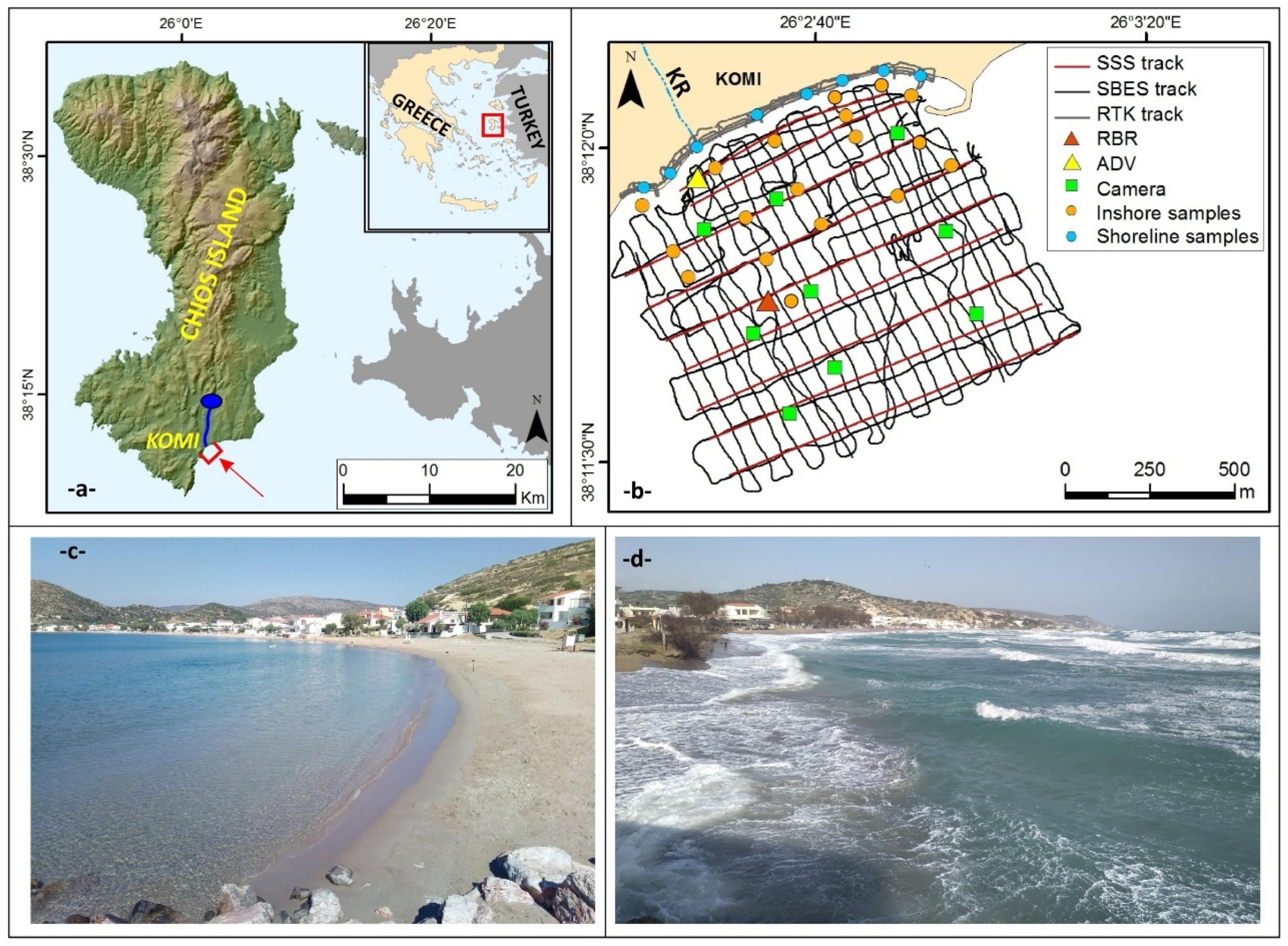
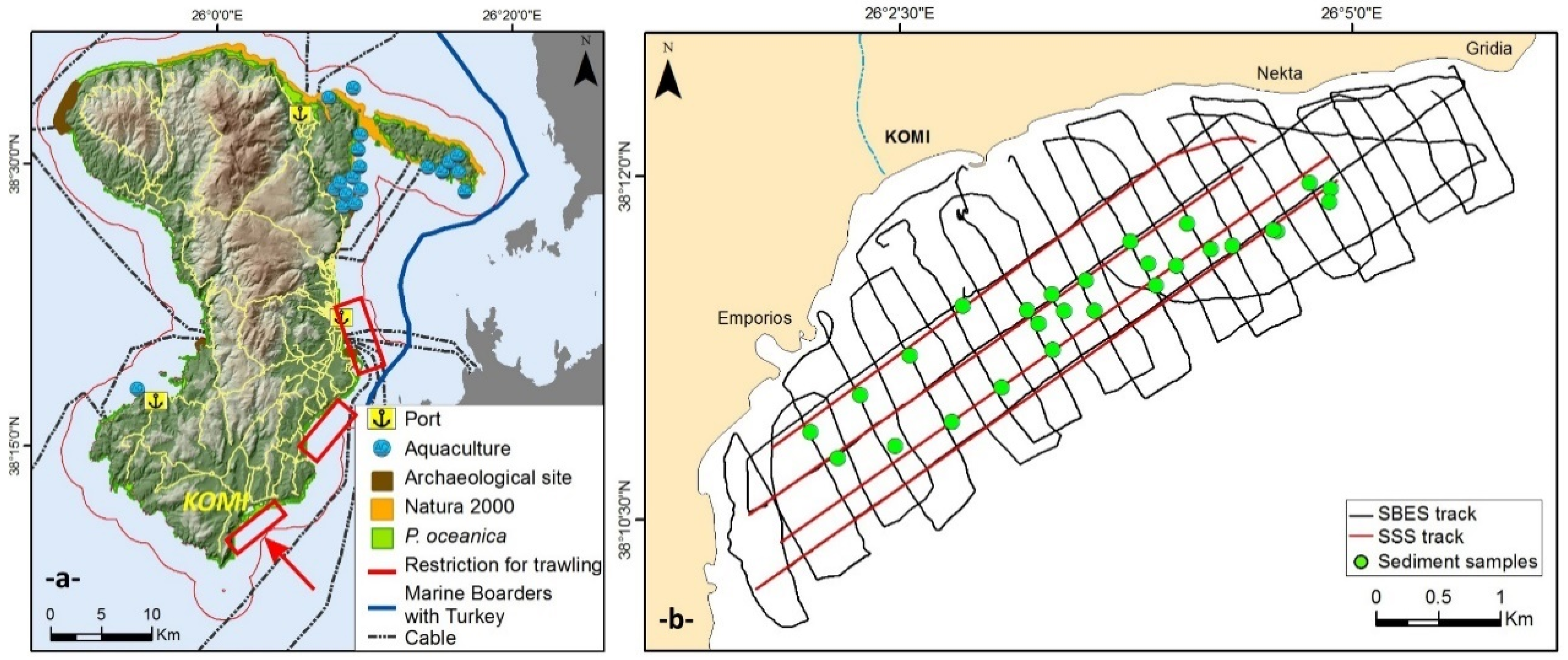


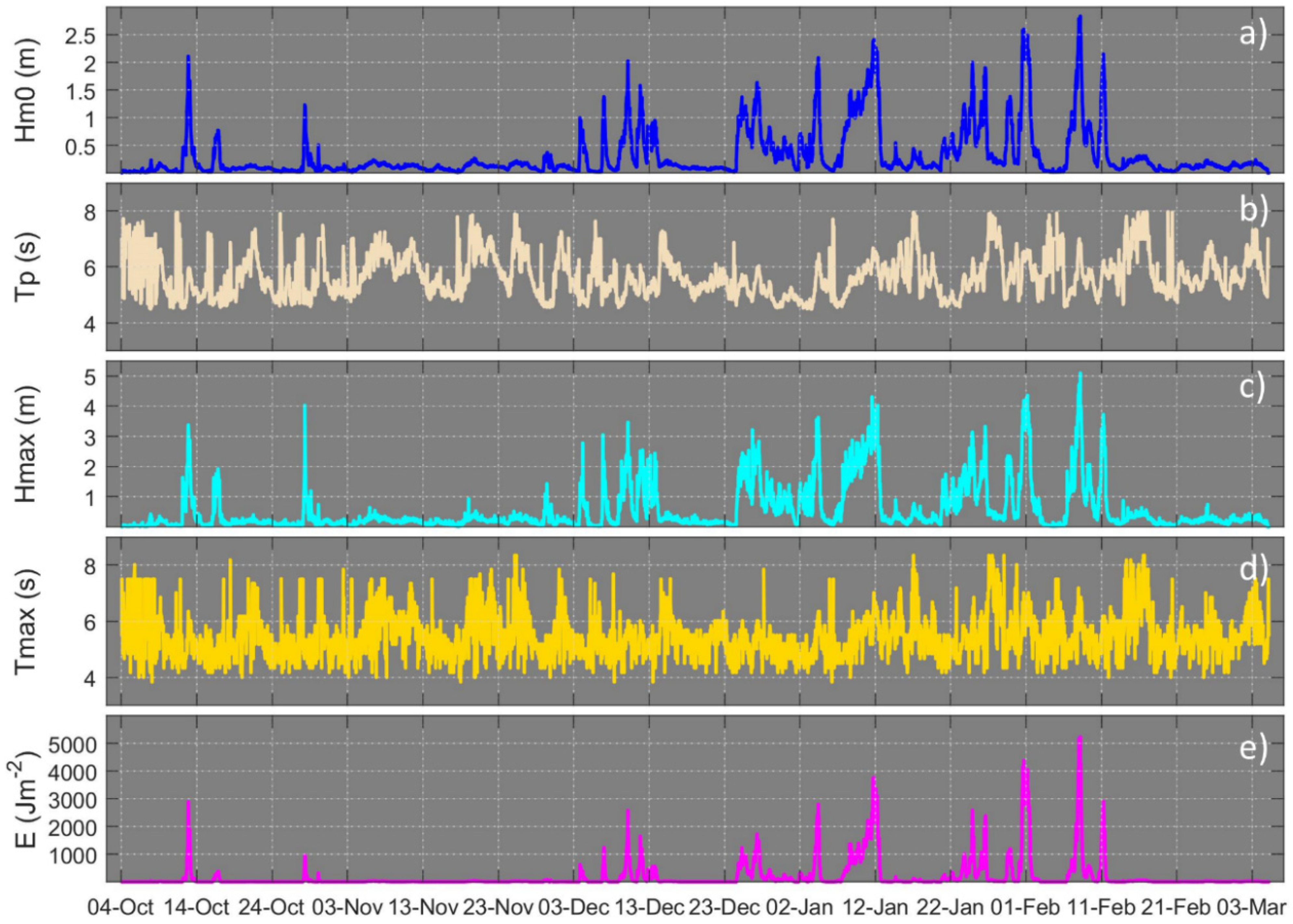
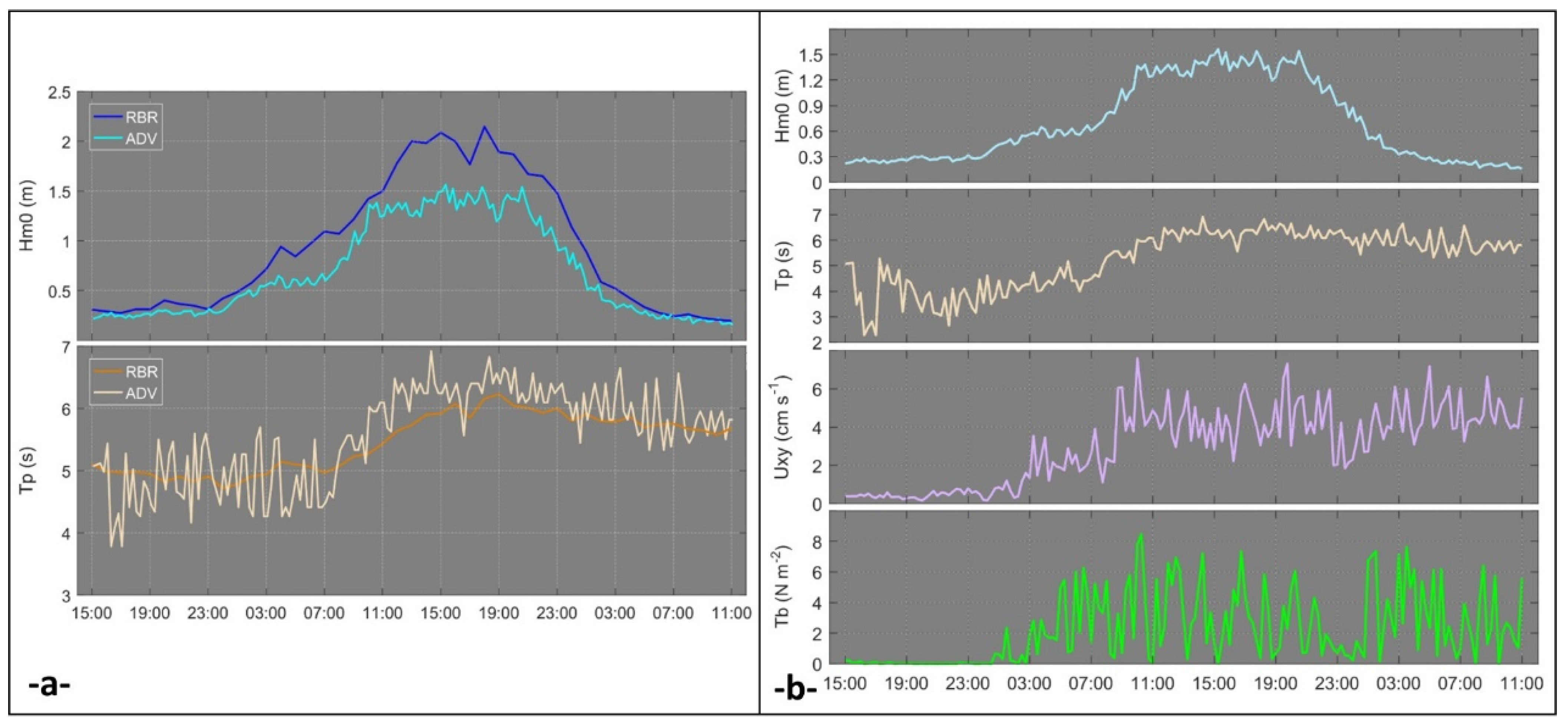
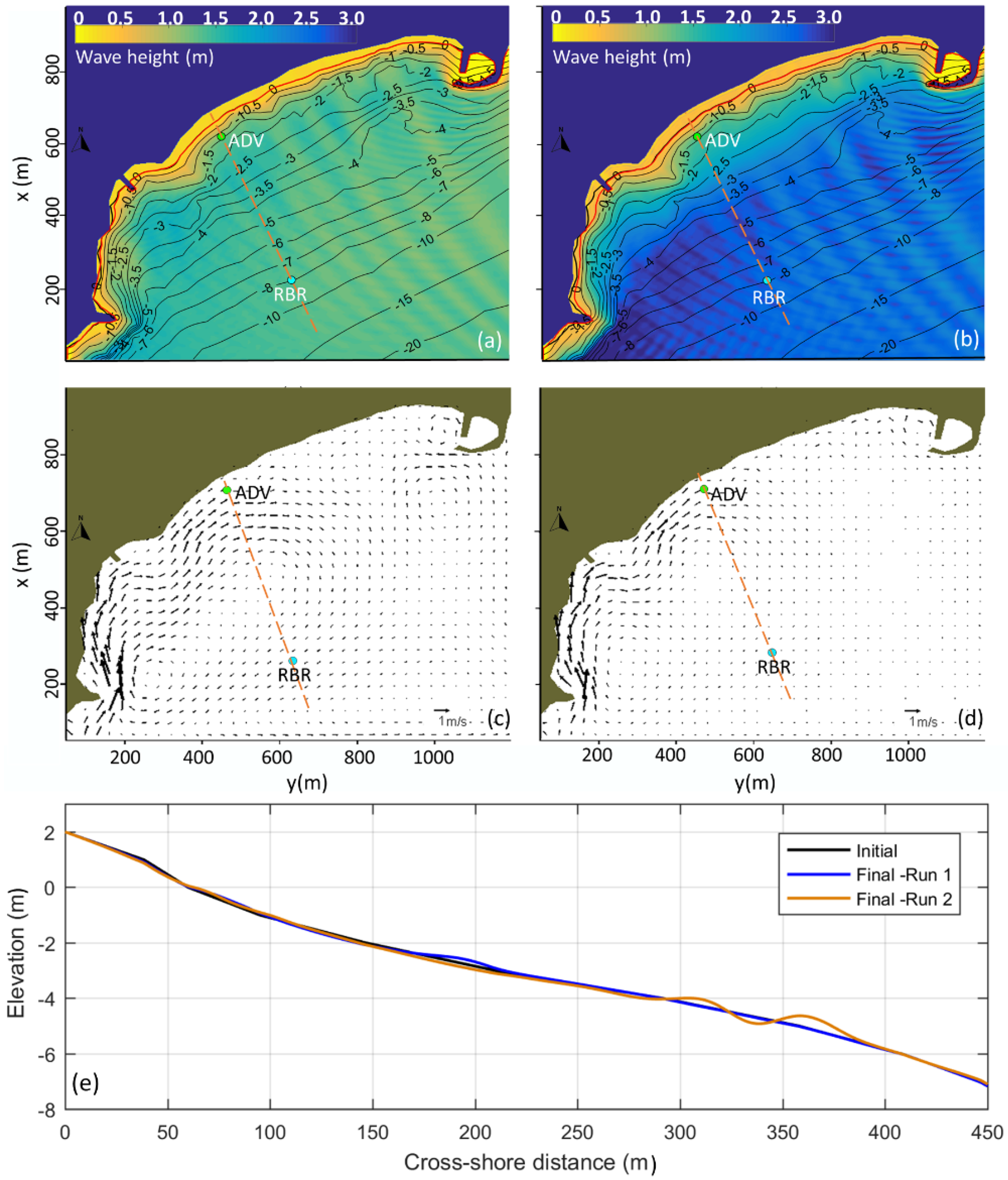
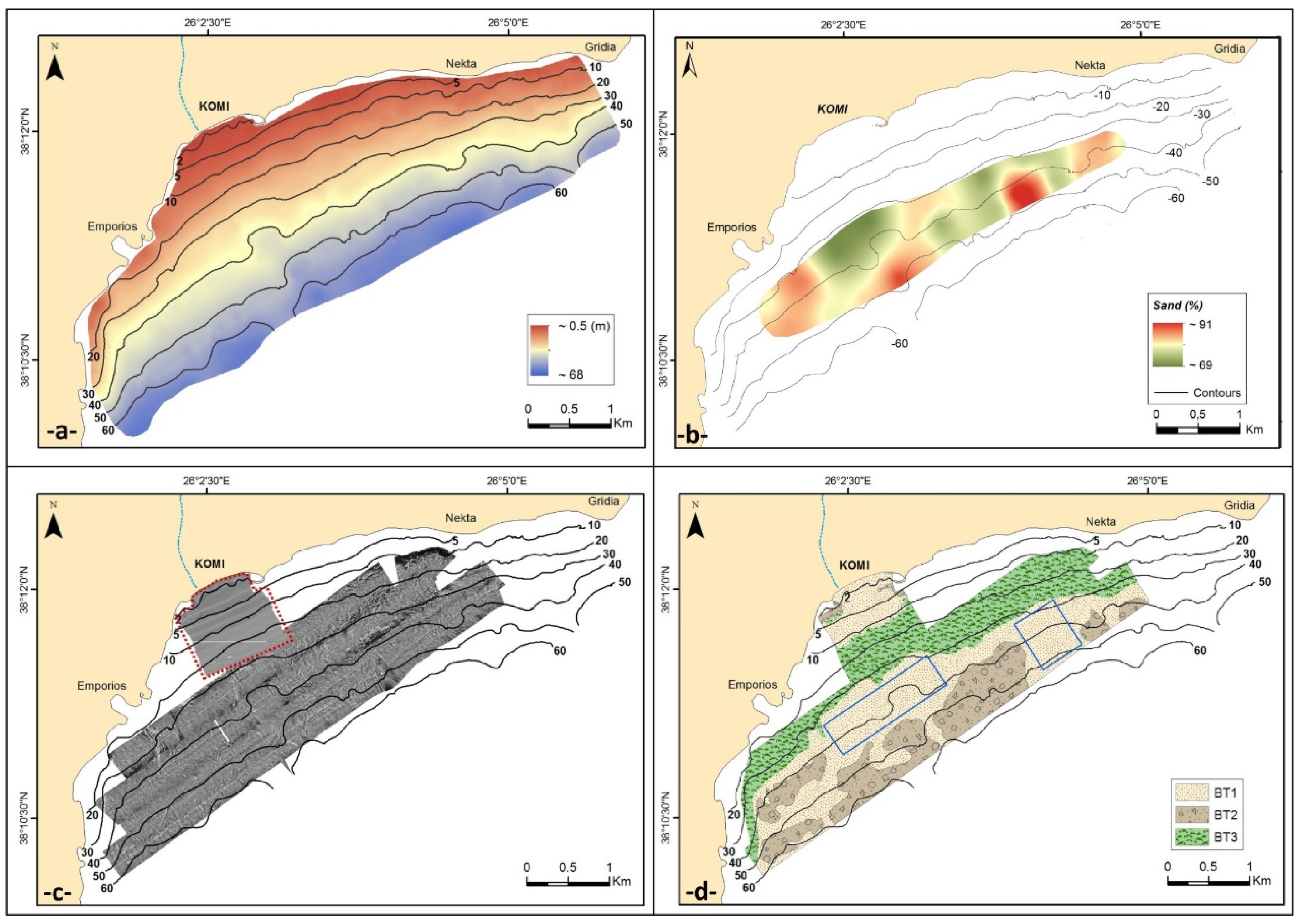
| February 2020 | July 2020 | October 2020 | January 2021 | February 2021 | |
|---|---|---|---|---|---|
| RTK beach and shoreline measurements | X | X | X | X | |
| Shoreline sampling | X | X | X | ||
| Inshore bathymetry, morphology, sampling | X | ||||
| Offshore bathymetry, morphology, sampling | X | ||||
| RBR data | Χ | X | X | ||
| High frequency ADV experiment | X | ||||
| Meteo data | X |
| Current | RCP4.5, 2050 | RCP4.5, 2100 | |||||||
|---|---|---|---|---|---|---|---|---|---|
| Beach Name | Score | RSLR + Tide (m) | Retreat Range (m) | Width Loss (%) | Score | RSLR + Tide (m) | Retreat Range (m) | Width Loss (%) | Score |
| 8. Giosonas | 0.044 | 0.3 | 3.3–11.4 | 16–54 | 0.046 | 0.63 | 6.6–21.7 | 32–100 | 0.045 |
| 34. Agios Isidoros | 0.024 | 0.3 | 3.3–11.4 | 37–100 | 0.025 | 0.63 | 6.6–21.7 | 74–100 | 0.025 |
| 36. Glaroi | 0.019 | 0.3 | 3.3–11.4 | 14–47 | 0.019 | 0.63 | 6.6–21.7 | 28–90 | 0.019 |
| 41. Ormos Lo | 0.085 | 0.3 | 3.3–11.4 | 37–100 | 0.089 | 0.63 | 6.6–21.7 | 74–100 | 0.087 |
| 53. Bella Vista | 0.077 | 0.22 | 2.5–8.9 | 6–22 | 0.076 | 0.54 | 5.7–18.9 | 14–46 | 0.076 |
| 60. Kontari | 0.075 | 0.22 | 2.5–8.9 | 10–37 | 0.074 | 0.54 | 5.7–18.9 | 24–79 | 0.074 |
| 63. Karfas | 0.092 | 0.22 | 2.5–8.9 | 8–27 | 0.090 | 0.54 | 5.7–18.9 | 17–57 | 0.091 |
| 65. Megas Limnionas | 0.090 | 0.22 | 2.5–8.9 | 21–24 | 0.089 | 0.54 | 5.7–18.9 | 48–100 | 0.090 |
| 72. Agia Fotini | 0.092 | 0.22 | 2.5–8.9 | 13–47 | 0.091 | 0.54 | 5.7–18.9 | 30–99 | 0.091 |
| 85. Viri | 0.068 | 0.22 | 2.5–8.9 | 15–53 | 0.067 | 0.54 | 5.7–18.9 | 34–100 | 0.067 |
| 90. Komi | 0.113 | 0.22 | 2.5–8.9 | 9–31 | 0.111 | 0.54 | 5.7–18.9 | 20–65 | 0.112 |
| 93. Mavra Volia | 0.026 | 0.22 | 2.5–8.9 | 8–28 | 0.026 | 0.54 | 5.7–18.9 | 18–59 | 0.026 |
| 118. Lithi | 0.087 | 0.24 | 2.7–9.5 | 8–30 | 0.087 | 0.57 | 6.0–19.8 | 19–62 | 0.087 |
| 133. Managros | 0.041 | 0.26 | 2.9–10.2 | 5–16 | 0.042 | 0.58 | 6.1–20.1 | 10–32 | 0.042 |
| 140. Agia Markella | 0.068 | 0.26 | 2.9–10.2 | 11–38 | 0.069 | 0.58 | 6.1–20.1 | 23–75 | 0.068 |
| Scenario ID | Nourishment Width (Δy0—m) | Nourishment Height (B—m) | Mean Grain Size of Nourishment Material (d50F—mm) | Volume of Nourishment Material per m of Beach (VN—m3/m) | Total Nourishment Volume (V—m3) | Total Cost (EUR) |
|---|---|---|---|---|---|---|
| (1) | 10 | 0.5 | 1.5 | 39 | 42,900 | 429,000 |
| (2) | 10 | 0.5 | 2.0 | 11 | 12,100 | 121,000 |
| (3) | 10 | 1.0 | 1.5 | 44 | 48,400 | 484,000 |
| (4) | 10 | 1.0 | 2.0 | 16 | 17,600 | 176,000 |
| (5) | 20 | 0.5 | 1.5 | 120 | 132,000 | 1,320,000 |
| (6) | 20 | 0.5 | 2.0 | 30 | 33,000 | 330,000 |
| (7) | 20 | 1.0 | 1.5 | 130 | 143,000 | 1,430,000 |
| (8) | 20 | 1.0 | 2.0 | 40 | 44,000 | 440,000 |
Publisher’s Note: MDPI stays neutral with regard to jurisdictional claims in published maps and institutional affiliations. |
© 2021 by the authors. Licensee MDPI, Basel, Switzerland. This article is an open access article distributed under the terms and conditions of the Creative Commons Attribution (CC BY) license (https://creativecommons.org/licenses/by/4.0/).
Share and Cite
Andreadis, O.; Chatzipavlis, A.; Hasiotis, T.; Monioudi, I.; Manoutsoglou, E.; Velegrakis, A. Assessment of and Adaptation to Beach Erosion in Islands: An Integrated Approach. J. Mar. Sci. Eng. 2021, 9, 859. https://doi.org/10.3390/jmse9080859
Andreadis O, Chatzipavlis A, Hasiotis T, Monioudi I, Manoutsoglou E, Velegrakis A. Assessment of and Adaptation to Beach Erosion in Islands: An Integrated Approach. Journal of Marine Science and Engineering. 2021; 9(8):859. https://doi.org/10.3390/jmse9080859
Chicago/Turabian StyleAndreadis, Olympos, Antonis Chatzipavlis, Thomas Hasiotis, Isavela Monioudi, Evangelia Manoutsoglou, and Adonis Velegrakis. 2021. "Assessment of and Adaptation to Beach Erosion in Islands: An Integrated Approach" Journal of Marine Science and Engineering 9, no. 8: 859. https://doi.org/10.3390/jmse9080859
APA StyleAndreadis, O., Chatzipavlis, A., Hasiotis, T., Monioudi, I., Manoutsoglou, E., & Velegrakis, A. (2021). Assessment of and Adaptation to Beach Erosion in Islands: An Integrated Approach. Journal of Marine Science and Engineering, 9(8), 859. https://doi.org/10.3390/jmse9080859









